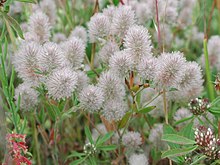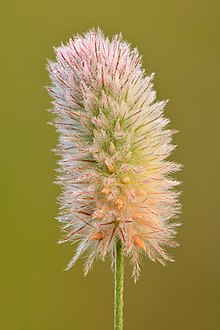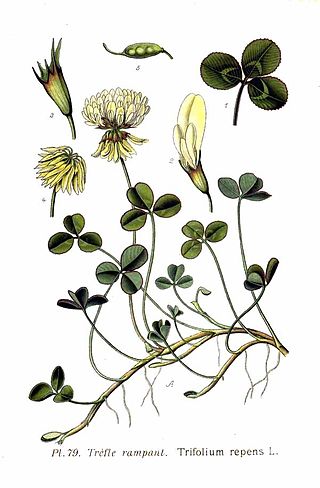
Clover, also called trefoil, are plants of the genus Trifolium, consisting of about 300 species of flowering plants in the legume family Fabaceae originating in Europe. The genus has a cosmopolitan distribution with highest diversity in the temperate Northern Hemisphere, but many species also occur in South America and Africa, including at high altitudes on mountains in the tropics. They are small annual, biennial, or short-lived perennial herbaceous plants, typically growing up to 30 centimetres (12 in) tall. The leaves are trifoliate, monofoliate, bifoliolate, quinquefoliolate, hexafoliolate, septafoliolate, etcetera, with stipules adnate to the leaf-stalk, and heads or dense spikes of small red, purple, white, or yellow flowers; the small, few-seeded pods are enclosed in the calyx. Other closely related genera often called clovers include Melilotus and Medicago.

The Fabaceae or Leguminosae, commonly known as the legume, pea, or bean family, are a large and agriculturally important family of flowering plants. It includes trees, shrubs, and perennial or annual herbaceous plants, which are easily recognized by their fruit (legume) and their compound, stipulate leaves. The family is widely distributed, and is the third-largest land plant family in number of species, behind only the Orchidaceae and Asteraceae, with about 765 genera and nearly 20,000 known species.
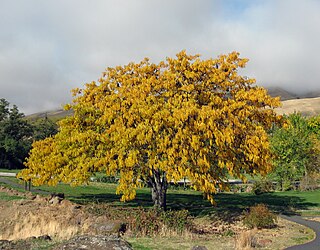
The honey locust, also known as the thorny locust or thorny honeylocust, is a deciduous tree in the family Fabaceae, native to central North America where it is mostly found in the moist soil of river valleys. Honey locust is highly adaptable to different environments, has been introduced worldwide, and can be an aggressive, invasive species outside of its native range.

A legume is a plant in the family Fabaceae, or the fruit or seed of such a plant. When used as a dry grain, the seed is also called a pulse. Legumes are grown agriculturally, primarily for human consumption, for livestock forage and silage, and as soil-enhancing green manure. Well-known legumes include beans, soybeans, chickpeas, peanuts, lentils, lupins, grass peas, mesquite, carob, tamarind, alfalfa, and clover. Legumes produce a botanically unique type of fruit – a simple dry fruit that develops from a simple carpel and usually dehisces on two sides.

In agriculture, cover crops are plants that are planted to cover the soil rather than for the purpose of being harvested. Cover crops manage soil erosion, soil fertility, soil quality, water, weeds, pests, diseases, biodiversity and wildlife in an agroecosystem—an ecological system managed and shaped by humans. Cover crops can increase microbial activity in the soil, which has a positive effect on nitrogen availability, nitrogen uptake in target crops, and crop yields. Cover crops may be an off-season crop planted after harvesting the cash crop. Cover crops are nurse crops in that they increase the survival of the main crop being harvested, and are often grown over the winter. In the United States, cover cropping may cost as much as $35 per acre.

Trifolium repens, the white clover, is a herbaceous perennial plant in the bean family Fabaceae. It is native to Europe, including the British Isles, and central Asia and is one of the most widely cultivated types of clover. It has been widely introduced worldwide as a forage crop, and is now also common in most grassy areas of North America, Australia and New Zealand. The species includes varieties often classed as small, intermediate and large, according to height, which reflects petiole length. The term 'white clover' is applied to the species in general, 'Dutch clover' is often applied to intermediate varieties, and 'ladino clover' is applied to large varieties.

Root nodules are found on the roots of plants, primarily legumes, that form a symbiosis with nitrogen-fixing bacteria. Under nitrogen-limiting conditions, capable plants form a symbiotic relationship with a host-specific strain of bacteria known as rhizobia. This process has evolved multiple times within the legumes, as well as in other species found within the Rosid clade. Legume crops include beans, peas, and soybeans.

Trifolium pratense, red clover, is a herbaceous species of flowering plant in the bean family Fabaceae, native to Europe, Western Asia, and northwest Africa, but planted and naturalized in many other regions.

Ulex europaeus, the gorse, common gorse, furze or whin, is a species of flowering plant in the family Fabaceae, native to the British Isles and Western Europe.

In agriculture, a living mulch is a cover crop interplanted or undersown with a main crop, and intended to serve the purposes of a mulch, such as weed suppression and regulation of soil temperature. Living mulches grow for a long time with the main crops, whereas cover crops are incorporated into the soil or killed with herbicides.

Melilotus, known as melilot, sweet clover, and kumoniga, is a genus in the family Fabaceae. Members are known as common grassland plants and as weeds of cultivated ground. Originally from Europe and Asia, it is now found worldwide.

Melilotus albus, known as honey clover, white melilot (UK), Bokhara clover (Australia), white sweetclover (USA), and sweet clover, is a nitrogen-fixing legume in the family Fabaceae. Melilotus albus is considered a valuable honey plant and source of nectar and is often grown for forage. Its characteristic sweet odor, intensified by drying, is derived from coumarin.

Trifolium incarnatum, known as crimson clover or Italian clover, is a species of short-growing flowering plant in the family Fabaceae, native to most of Europe. It has been introduced to other areas, including the United States and Japan.

Dalea searlsiae, commonly known as Searls' prairie clover, is a perennial legume species belonging to the Dalea genus. The species is found through arid regions of the southwestern United States and can survive in low moisture conditions. The species forms symbiotic relationships with nitrogen-fixing bacteria that can improve soil nutrient levels. Its large inflorescence attracts many species of pollinators, and it lacks toxins found in similar legume species. As a result, the species has been considered for use in rangeland restoration and revegetation projects.

Medicago lupulina, commonly known as black medick, nonesuch, or hop clover, is a plant of dry grassland belonging to the legume or clover family. Plants of the genus Medicago, or bur clovers, are closely related to the true clovers (Trifolium) and sweet clover (Melilotus). Like the true clovers, black medick has three leaflets and a small, yellow flower closely resembling those of lesser trefoil. Black medick belongs to the same genus as alfalfa.

Macroptilium atropurpureum, commonly referred to as purple bush-bean, or siratro is a perennial legume recognized by its climbing, dense, green vines and deep purple flowers. The plant is indigenous to the tropical and subtropical regions of North, Central, and South America, as far north as Texas in the USA and as far south as Peru and Brazil. It has been introduced for use as a food for stock to many tropical regions around the world. It has become an invasive pest plant in a number of areas, including the north-eastern coast of Australia. Rich in protein, M. atropurpureum is commonly used for cattle pastures intercropped with grass, used in hay, or as a ground cover to prevent soil erosion and to improve soil quality.

Pachyrhizus ahipa, also called the ahipa or Andean yam bean, is a tuberous root-producing legume, which is mainly distributed in the Andean region.

Trigonella suavissima is a herbaceous plant that is endemic to Australia. It is a member of the genus Trigonella and the family Fabaceae. Common names include Cooper clover, Menindee clover, calomba, Darling trigonella, sweet fenugreek, channel clover, sweet-scented clover and Australian shamrock.

Alysicarpus vaginalis is a species of flowering plant in the legume family, Fabaceae. It is native to parts of Africa and Asia, and it has been introduced to other continents, such as Australia and the Americas. It is cultivated as a fodder for livestock, for erosion control, and as a green manure. Common names include alyce clover, buffalo clover, buffalo-bur, one-leaf clover, and white moneywort.
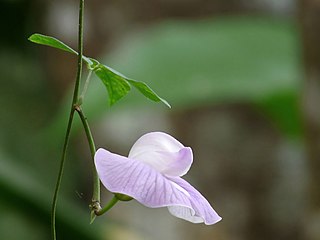
Centrosema pubescens, common name centro or butterfly pea, is a legume in the family Fabaceae, subfamily Faboideae, and tribe Phaseolae. It is native to Central and South America and cultivated in other tropical areas as a forage for livestock.
